2012 SUBARU TRIBECA door lock
[x] Cancel search: door lockPage 254 of 420
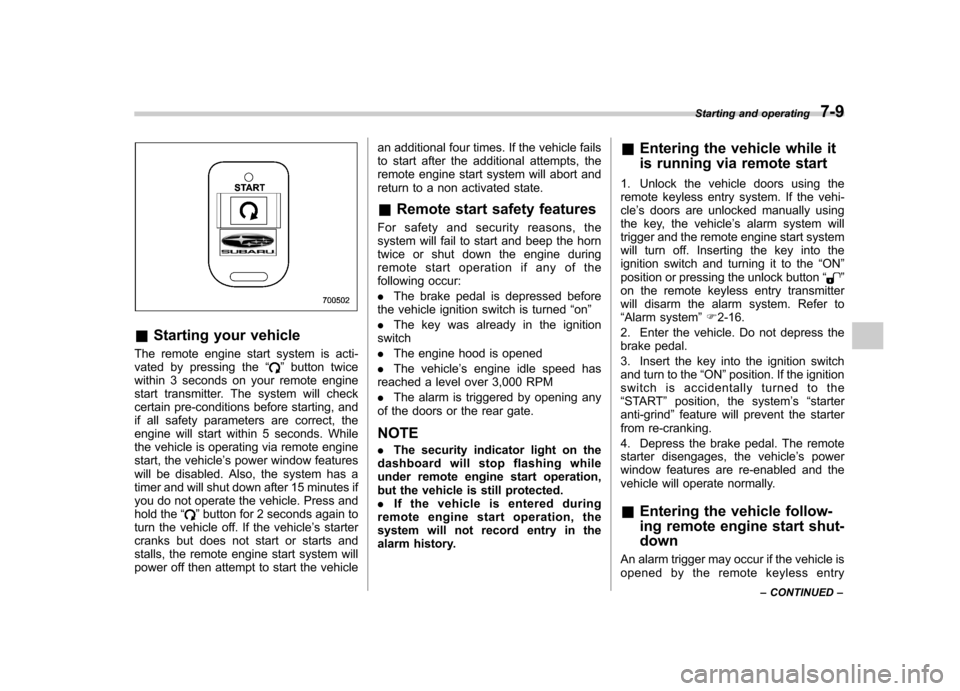
&Starting your vehicle
The remote engine start system is acti-
vated by pressing the “
”button twice
within 3 seconds on your remote engine
start transmitter. The system will check
certain pre-conditions before starting, and
if all safety parameters are correct, the
engine will start within 5 seconds. While
the vehicle is operating via remote engine
start, the vehicle ’s power window features
will be disabled. Also, the system has a
timer and will shut down after 15 minutes if
you do not operate the vehicle. Press and
hold the “
”button for 2 seconds again to
turn the vehicle off. If the vehicle ’s starter
cranks but does not start or starts and
stalls, the remote engine start system will
power off then attempt to start the vehicle an additional four times. If the vehicle fails
to start after the additional attempts, the
remote engine start system will abort and
return to a non activated state.
& Remote start safety features
For safety and security reasons, the
system will fail to start and beep the horn
twice or shut down the engine during
remote start operation if any of the
following occur: . The brake pedal is depressed before
the vehicle ignition switch is turned “on ”
. The key was already in the ignition
switch. The engine hood is opened
. The vehicle ’s engine idle speed has
reached a level over 3,000 RPM. The alarm is triggered by opening any
of the doors or the rear gate.
NOTE . The security indicator light on the
dashboard will stop flashing while
under remote engine start operation,
but the vehicle is still protected.. If the vehicle is entered during
remote engine start operation, the
system will not record entry in the
alarm history. &
Entering the vehicle while it
is running via remote start
1. Unlock the vehicle doors using the
remote keyless entry system. If the vehi-cle ’s doors are unlocked manually using
the key, the vehicle ’s alarm system will
trigger and the remote engine start system
will turn off. Inserting the key into the
ignition switch and turning it to the “ON ”
position or pressing the unlock button “
”
on the remote keyless entry transmitter
will disarm the alarm system. Refer to“ Alarm system ”F 2-16.
2. Enter the vehicle. Do not depress the
brake pedal.
3. Insert the key into the ignition switch
and turn to the “ON ”position. If the ignition
switch is accidentally turned to the“ START ”position, the system ’s “starter
anti-grind ”feature will prevent the starter
from re-cranking.
4. Depress the brake pedal. The remote
starter disengages, the vehicle ’s power
window features are re-enabled and the
vehicle will operate normally.
& Entering the vehicle follow-
ing remote engine start shut-down
An alarm trigger may occur if the vehicle is
opened by the remote keyless entry Starting and operating
7-9
– CONTINUED –
Page 285 of 420
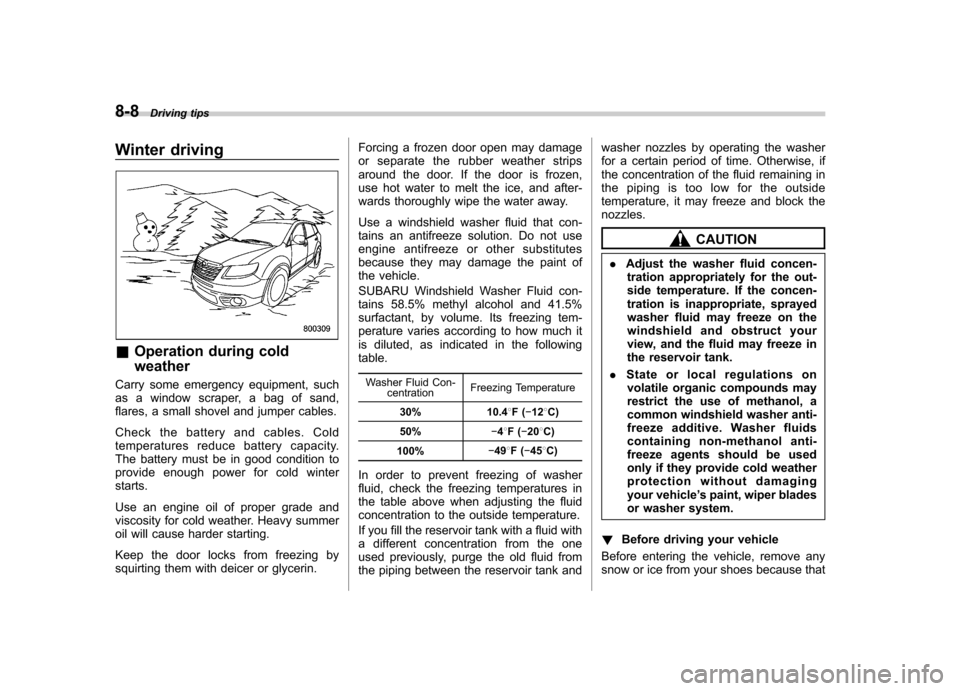
8-8Driving tips
Winter driving
&Operation during cold weather
Carry some emergency equipment, such
as a window scraper, a bag of sand,
flares, a small shovel and jumper cables.
Check the battery and cables. Cold
temperatures reduce battery capacity.
The battery must be in good condition to
provide enough power for cold winterstarts.
Use an engine oil of proper grade and
viscosity for cold weather. Heavy summer
oil will cause harder starting.
Keep the door locks from freezing by
squirting them with deicer or glycerin. Forcing a frozen door open may damage
or separate the rubber weather strips
around the door. If the door is frozen,
use hot water to melt the ice, and after-
wards thoroughly wipe the water away.
Use a windshield washer fluid that con-
tains an antifreeze solution. Do not use
engine antifreeze or other substitutes
because they may damage the paint of
the vehicle.
SUBARU Windshield Washer Fluid con-
tains 58.5% methyl alcohol and 41.5%
surfactant, by volume. Its freezing tem-
perature varies according to how much it
is diluted, as indicated in the followingtable.
Washer Fluid Con- centration Freezing Temperature
30% 10.4 8F( �12 8C)
50% �48F( �20 8C)
100% �
49 8F( �45 8C)
In order to prevent freezing of washer
fluid, check the freezing temperatures in
the table above when adjusting the fluid
concentration to the outside temperature.
If you fill the reservoir tank with a fluid with
a different concentration from the one
used previously, purge the old fluid from
the piping between the reservoir tank and washer nozzles by operating the washer
for a certain period of time. Otherwise, if
the concentration of the fluid remaining in
the piping is too low for the outside
temperature, it may freeze and block thenozzles.
CAUTION
. Adjust the washer fluid concen-
tration appropriately for the out-
side temperature. If the concen-
tration is inappropriate, sprayed
washer fluid may freeze on the
windshield and obstruct your
view, and the fluid may freeze in
the reservoir tank.
. State or local regulations on
volatile organic compounds may
restrict the use of methanol, a
common windshield washer anti-
freeze additive. Washer fluids
containing non-methanol anti-
freeze agents should be used
only if they provide cold weather
protection without damaging
your vehicle ’s paint, wiper blades
or washer system.
! Before driving your vehicle
Before entering the vehicle, remove any
snow or ice from your shoes because that
Page 323 of 420
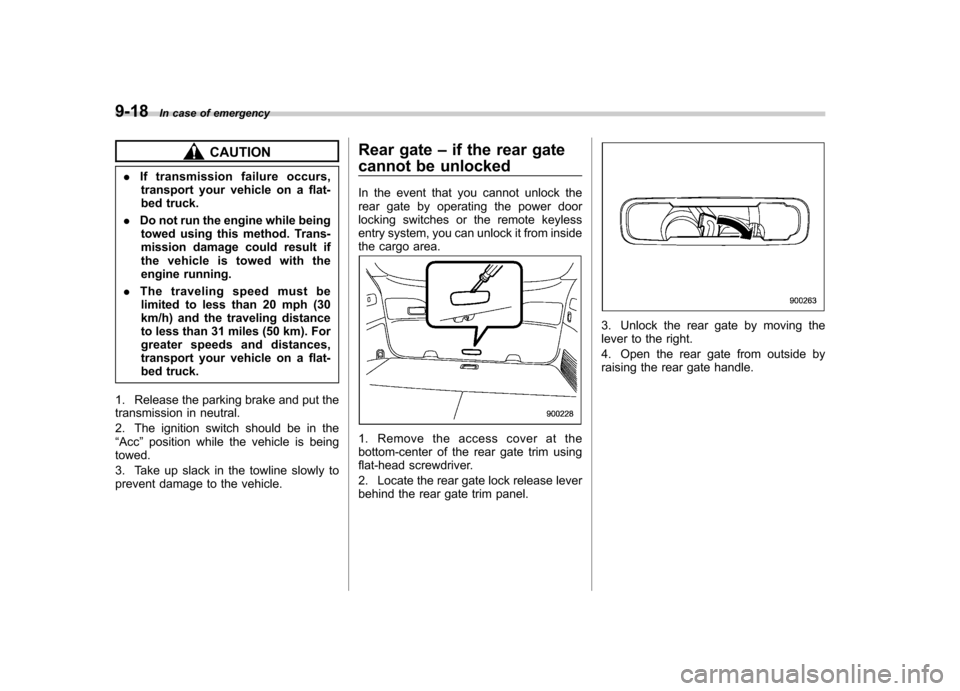
9-18In case of emergency
CAUTION
. If transmission failure occurs,
transport your vehicle on a flat-
bed truck.
. Do not run the engine while being
towed using this method. Trans-
mission damage could result if
the vehicle is towed with the
engine running.
. The traveling speed must be
limited to less than 20 mph (30
km/h) and the traveling distance
to less than 31 miles (50 km). For
greater speeds and distances,
transport your vehicle on a flat-
bed truck.
1. Release the parking brake and put the
transmission in neutral.
2. The ignition switch should be in the “ Acc ”position while the vehicle is being
towed.
3. Take up slack in the towline slowly to
prevent damage to the vehicle. Rear gate
–if the rear gate
cannot be unlocked
In the event that you cannot unlock the
rear gate by operating the power door
locking switches or the remote keyless
entry system, you can unlock it from inside
the cargo area.
1. Remove the access cover at the
bottom-center of the rear gate trim using
flat-head screwdriver.
2. Locate the rear gate lock release lever
behind the rear gate trim panel.
3. Unlock the rear gate by moving the
lever to the right.
4. Open the rear gate from outside by
raising the rear gate handle.
Page 329 of 420
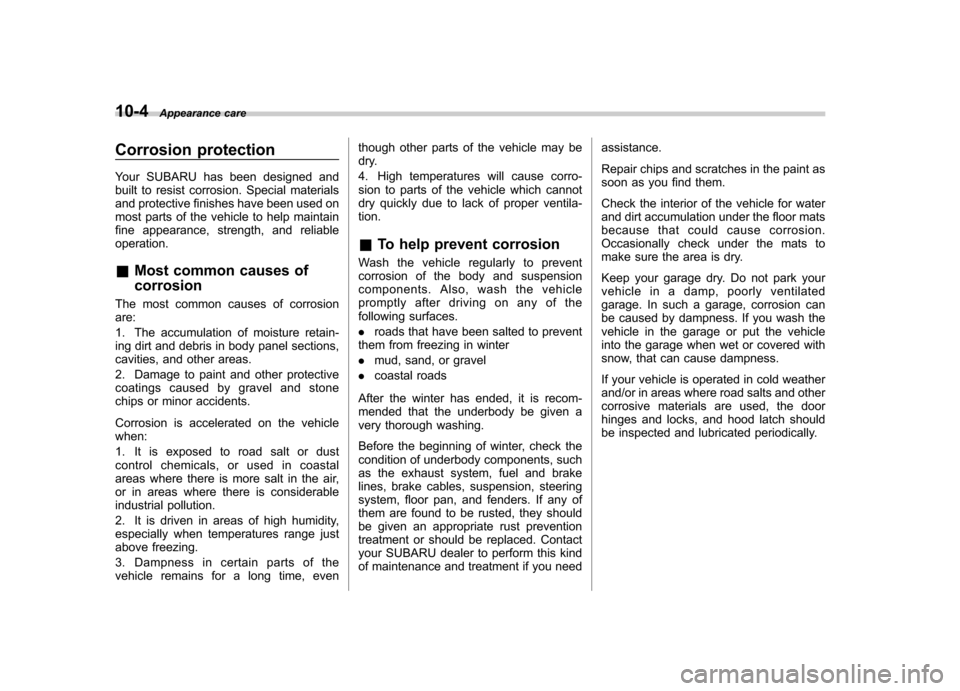
10-4Appearance care
Corrosion protection
Your SUBARU has been designed and
built to resist corrosion. Special materials
and protective finishes have been used on
most parts of the vehicle to help maintain
fine appearance, strength, and reliableoperation. &Most common causes of corrosion
The most common causes of corrosion are:
1. The accumulation of moisture retain-
ing dirt and debris in body panel sections,
cavities, and other areas.
2. Damage to paint and other protective
coatings caused by gravel and stone
chips or minor accidents.
Corrosion is accelerated on the vehicle when:
1. It is exposed to road salt or dust
control chemicals, or used in coastal
areas where there is more salt in the air,
or in areas where there is considerable
industrial pollution.
2. It is driven in areas of high humidity,
especially when temperatures range just
above freezing.
3. Dampness in certain parts of the
vehicle remains for a long time, even though other parts of the vehicle may be
dry.
4. High temperatures will cause corro-
sion to parts of the vehicle which cannot
dry quickly due to lack of proper ventila-tion.
& To help prevent corrosion
Wash the vehicle regularly to prevent
corrosion of the body and suspension
components. Also, wash the vehicle
promptly after driving on any of the
following surfaces. . roads that have been salted to prevent
them from freezing in winter. mud, sand, or gravel
. coastal roads
After the winter has ended, it is recom-
mended that the underbody be given a
very thorough washing.
Before the beginning of winter, check the
condition of underbody components, such
as the exhaust system, fuel and brake
lines, brake cables, suspension, steering
system, floor pan, and fenders. If any of
them are found to be rusted, they should
be given an appropriate rust prevention
treatment or should be replaced. Contact
your SUBARU dealer to perform this kind
of maintenance and treatment if you need assistance.
Repair chips and scratches in the paint as
soon as you find them.
Check the interior of the vehicle for water
and dirt accumulation under the floor mats
because that could cause corrosion.
Occasionally check under the mats to
make sure the area is dry.
Keep your garage dry. Do not park your
vehicle in a damp, poorly ventilated
garage. In such a garage, corrosion can
be caused by dampness. If you wash the
vehicle in the garage or put the vehicle
into the garage when wet or covered with
snow, that can cause dampness.
If your vehicle is operated in cold weather
and/or in areas where road salts and other
corrosive materials are used, the door
hinges and locks, and hood latch should
be inspected and lubricated periodically.
Page 384 of 420

Fuses and circuits &Fuse panel located in the passenger compartmentFuse
panel Fuse
rating Circuit
1 20A .Trailer hitch connector
2 Empty
3 15A .Door locking
4 7.5A .Front wiper deicer relay
. Moonroof
5 7.5A .Combination meter
6 7.5A .Remote control rear
view mirrors
. Seat heater relay
7 15A .Combination meter
. Integrated unit
8 15A .Stop light
9 20A .Mirror heater
. Front wiper deicer
10 7.5A .Power supply (battery)
11 7.5A .Turn signal unit
12 15A .Automatic transmission
unit
. SRS airbag system
(sub)
. Engine control unit
. Integrated unitSpecifications
12-9
– CONTINUED –
Page 411 of 420

14-4Index
Second-row seat ...................................................... 6-9
Third-row seat ......................................................... 6-9
D
Daytime running light system ....................................... 3-29
Differential gear oil Front ........................................................... 11-15, 12-6
Rear ............................................................ 11-16, 12-6
Dimensions ............................................................... 12-2
Disarming the alarm system ........................................ 2-18
Disc brake pad wear warning indicators ........................ 7-20
Dome light ........................................................ 6-2, 11-42
Door Locks ..................................................................... 2-5
Open warning light ................................................. 3-17
Step light ............................................................. 11-43
Drive belts. ............................................................... 11-13
Driving All-Wheel Drive warning light ................................... 3-18
AWD vehicles .......................................................... 8-4
Car phone/cell phone .................................................. 8
Drinking ..................................................................... 7
Drugs ........................................................................ 7
Foreign countries ..................................................... 8-4
Pets .......................................................................... 8
Snowy and icy roads ................................................ 8-9
Tips.................................................................. 8-2, 8-4
Tired or sleepy. ........................................................... 7
Winter .................................................................... 8-8 E
Electrical system
........................................................ 12-7
Electronic Brake Force Distribution (EBD) system... 3-16, 7-22
Emergency Locking Retractor (ELR) ............................. 1-18
Engine Compartment overview ............................................ 11-6
Coolant ....................................................... 11-11, 12-7
Exhaust gas (carbon monoxide) ............................. 6, 8-2
Hood .................................................................... 11-4
Oil ................................................................ 11-7, 12-4 Overheating ........................................................... 9-14
Starting .................................................................. 7-7
Stopping ................................................................. 7-8
Exterior care .............................................................. 10-2
F
Flat tires ..................................................................... 9-6
Floor mat ................................................................... 6-13
Fluid level Automatic transmission ......................................... 11-14
Brake .................................................................. 11-17
Power steering ..................................................... 11-16
Fog light Bulb .......................................................... 11-39, 12-12
Indicator light ......................................................... 3-22
Switch ................................................................... 3-32
Folding mirror switch ................................................... 3-43
Front
Differential gear oil ........................................ 11-15, 12-6
Fog light ...................................................... 3-32, 11-39
Fog light indicator light ............................................ 3-22
Page 414 of 420
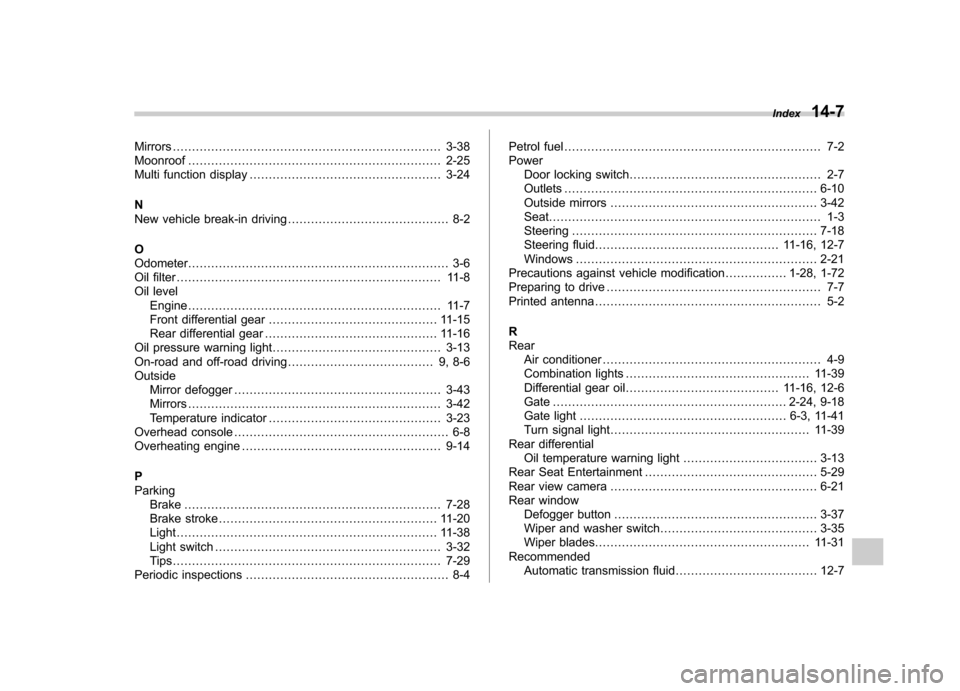
Mirrors...................................................................... 3-38
Moonroof .................................................................. 2-25
Multi function display .................................................. 3-24
N
New vehicle break-in driving .......................................... 8-2
O Odometer .................................................................... 3-6
Oil filter ..................................................................... 11-8
Oil level Engine .................................................................. 11-7
Front differential gear ............................................ 11-15
Rear differential gear ............................................. 11-16
Oil pressure warning light ............................................ 3-13
On-road and off-road driving ...................................... 9, 8-6
Outside Mirror defogger ...................................................... 3-43
Mirrors .................................................................. 3-42
Temperature indicator ............................................. 3-23
Overhead console ........................................................ 6-8
Overheating engine .................................................... 9-14
PParking Brake ................................................................... 7-28
Brake stroke ......................................................... 11-20
Light .................................................................... 11-38
Light switch ........................................................... 3-32
Tips...................................................................... 7-29
Periodic inspections ..................................................... 8-4 Petrol fuel
................................................................... 7-2
Power Door locking switch .................................................. 2-7
Outlets .................................................................. 6-10
Outside mirrors ...................................................... 3-42
Seat ....................................................................... 1-3
Steering ................................................................ 7-18
Steering fluid ................................................ 11-16, 12-7
Windows ............................................................... 2-21
Precautions against vehicle modification ................ 1-28, 1-72
Preparing to drive ........................................................ 7-7
Printed antenna ........................................................... 5-2
RRear Air conditioner ......................................................... 4-9
Combination lights ................................................ 11-39
Differential gear oil ........................................ 11-16, 12-6
Gate ............................................................. 2-24, 9-18
Gate light ...................................................... 6-3, 11-41
Turn signal light .................................................... 11-39
Rear differential Oil temperature warning light ................................... 3-13
Rear Seat Entertainment ............................................. 5-29
Rear view camera ...................................................... 6-21
Rear window Defogger button ..................................................... 3-37
Wiper and washer switch ......................................... 3-35
Wiper blades ........................................................ 11-31
Recommended
Automatic transmission fluid ..................................... 12-7Index
14-7